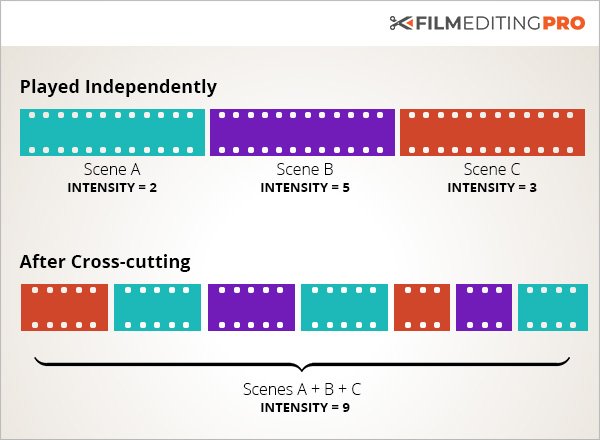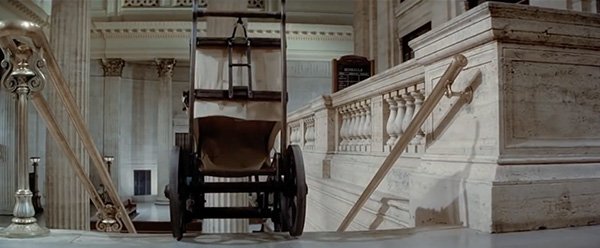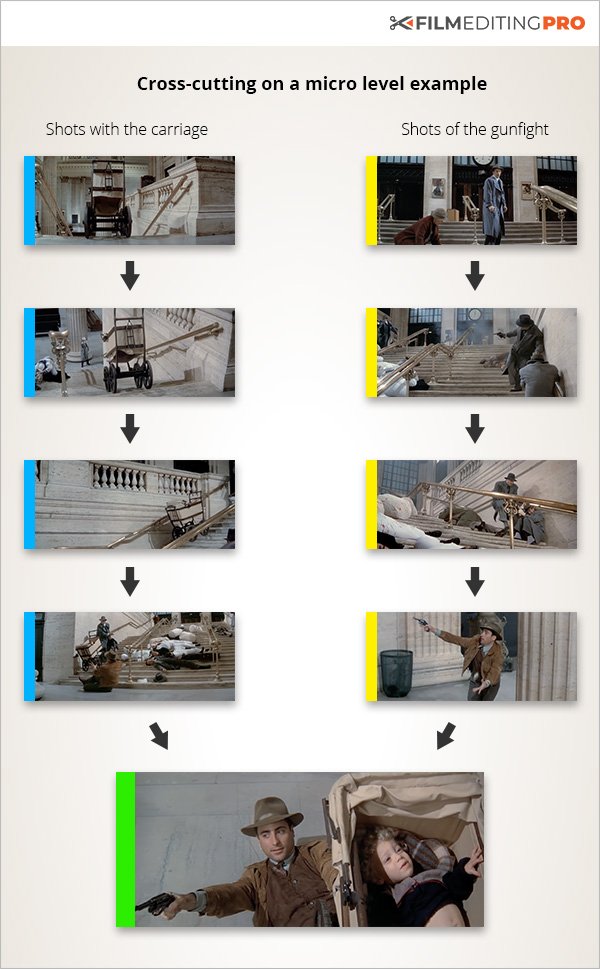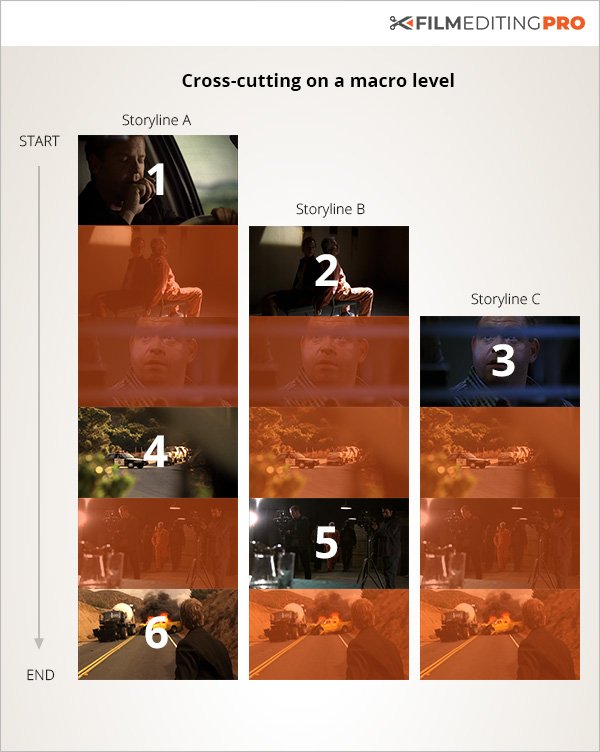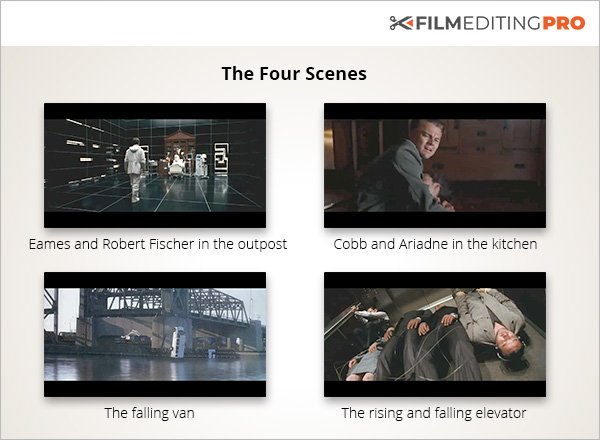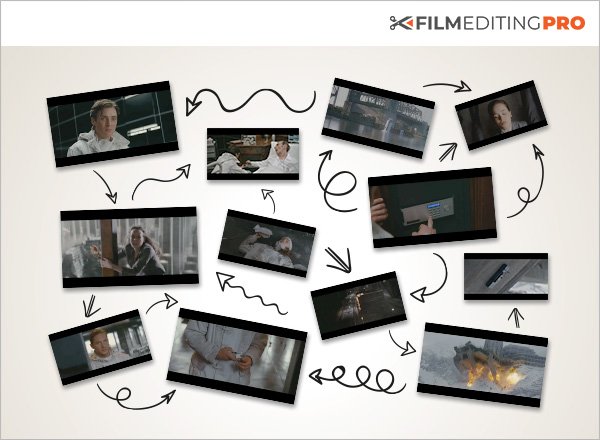So, you’ve found your first client, congratulations! After all that hard work and grind, someone…

Film Editing Techniques: Cross-Cutting 101
Every year, it seems like the bar is pushed just a little higher with films and television. Film editing techniques are always evolving. The action is bigger, the drama is more dramatic and the suspense is even “suspensier” (not even close to being a word?)
Let’s just say that grabbing and holding audience interest isn’t getting any easier.
Although every situation is different, top editors have a reliable arsenal of time-tested techniques for increasing the pace of the film and keeping the viewer on the edge of their seats.
Chief among these tools is cross-cutting.
What is Cross-cutting?
Cross-cutting is a deceptively simple editing technique that delivers a big dramatic punch.
In a nutshell, cross-cutting is taking two or more film sequences and cutting between them as they progress. It sounds simple but is in fact a very complicated technique that requires a firm grasp on pacing and timing.
It can take a handful of scenes, which played independently, might each register as a 3 or 4 on the intensity scale. After cross-cutting, you could ratchet them up to a 9 or a 10 by weaving their progression together.
Here are the two main types of cross-cutting you’ll probably encounter.
Cross-cutting on a Micro Level
When cross-cutting occurs with a fairly quick back-and-forth pace between activities in one or two scenes, we can think of it as cross-cutting on a micro level.
Here’s a great example.
In a famous scene from the film Untouchables, there’s a shootout at Union Station between Kevin Costner’s character and some mobsters. During the chaos, a baby in a stroller gets bumped and starts rolling down the stairs.
The dramatic momentum of the falling carriage is intercut with shots of the gunfight, increasing the stress and tension with every edit. The overall intensity of the emotion becomes greater than the sum of its parts.
Eventually, the two lines of action converge at the end of the scene when Costner is the victor of the gunfight and Andy Garcia barely stops the stroller from crashing at the bottom of the stairs.
A main theme of cross-cutting, whether macro or micro is that the cross-cut events do eventually meet, whether geographically or just dramatically.
This is a smaller scale example because the cross-cuts are happening in only one scene, back and forth between two actions.
Cross-cutting on a Macro Level
Sometimes thought of as “parallel editing”, cross-cutting can occur on a more macro level. If you zoom out far enough, you might even view it as cutting parallel storylines.
We see a lot of this type of cross-cutting on television. Many of your favorite shows will feature several members of the main cast doing one thing, while the rest of the characters are doing something else.
Take, for example, any episode of Fox’s 24.
You might have Storyline A, where Jack Bauer orders police to keep an eye on a car he hopes will lead them to some hostages.
Then crosscut to Storyline B, where we see the hostages, get to know them and become emotionally invested in their well-being.
Then crosscut to Storyline C, where we’re at the police headquarters, complete with a whole new set of character drama and complications.
As the episode progresses, the 3 storylines are woven together as they escalate toward the ultimate climax where the 3 lines of action will converge – just like we saw on a micro level within a scene. The obvious difference is that this macro-level cross-cutting takes place over the course of 60 minutes instead of 5-10.
Cross-cutting like this is a great way to do three things:
- Break up long scenes
- Keep people guessing
- Continue moving all the different storylines forward.
Taking Cross-cutting to the Next Level
Perhaps one of the most famous examples of cross-cutting, executed on a grand scale, is in Christopher Nolan’s science fiction thriller Inception.
If you haven’t seen it (spoiler alert), the film is about a team of thieves who hack into the subconscious minds of those they plan to rob. What they’re after is information.
They are offered a chance to have their criminal history erased by hacking into the mind of a high-level target and implanting an idea. In order to do this, they must head deeper and deeper into his subconscious.
During the climax of the film, there are several different events occurring simultaneously. This is where the cross-cutting technique came in handy, as it allowed the director and editor the ability to seamlessly jump between the events, keeping the tension from one scene at the same level as the tension from another. Meanwhile, all the scenes move toward the ultimate climax.
As illustrated here, there are four distinct events:
The editor had to choose very specific moments from each of these separate scenes and place them into the right order. We won’t even bother breaking down the specific back and forth cutting in this film sequence because it’s incredibly complicated.
If you really want to scramble your brain, try cross-cutting a scene like this – multiple locations, multiple characters, across multiple versions of time on multiple levels of a dream. God help the poor editor that faces a challenge like this!
Do’s and Don’ts of Cross-cutting
DO: Consider the purpose of each scene.
Before you start to construct your exciting sequence of cross-cut events, think about how each scene will affect the others around it. For example let’s say you have a bomb timer counting down. Pretty classic device. You’d want to intermittently use portions of this scene as a way of reminding the audience that there is an urgent deadline approaching. This is a basic example but illustrates proper use of the technique.
DO: Use this technique to help with pacing
Cross-cutting is a terrific way to speed things up or slow them down. Each little vignette you cut to can be as long or as short as you want. Just bear in mind that hanging on any given shot for too long could slow down the momentum. Conversely, cutting away too quickly might be confusing for the viewer. You’ll need to use your best judgement.
DON’T: Lose track of where everyone is
Remember that as an editor it’s our job to help the audience understand what’s happening. By cutting away from one scene and focusing on another, it’s important to remind the audience of where they are when you change the scene.
You need to think carefully about when to use your various close-ups vs your wide, establishing shots. Use too many close-ups and the location changes could get confusing. On the other hand, use too many wide shots and the pace will grind to a halt and the constant re-establishing coverage will feel redundant.
DON’T: Cut away haphazardly
The fun thing about this technique is that you can cut in or out of any moment and leave the viewer hanging on the edge of their seat for what will happen next. Just be careful not to cut away haphazardly or randomly. There should be some level of micro-resolution before bouncing to the next scene.
Oftentimes, a great place to cut away will be after a character visibly reacts to something that has just occurred. This prevents the cross-cutting from feeling like a bunch of random shots placed back-to-back and helps to push the human drama forward in the story.
Wrap Up
The idea of cross cutting isn’t something new. However, that doesn’t diminish its impact as a powerful editing technique. You can use this tool in just about every genre in pieces of all shapes and sizes – from a full-length action feature to a 2 minute horror trailer. It’s incredibly versatile and worth spending a bit of time to practice.
It’s tempting for editors to always search for the “new feature” or the “latest trick”, but sometimes it’s the classic, reliable tools that we really need to be using. After all, the hammer has been around for a few thousand years…and I don’t see it going anywhere.
Leave Your Thoughts & Comments Below:
